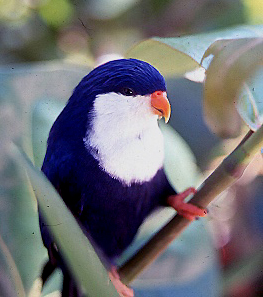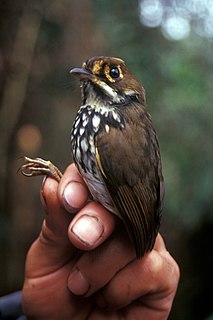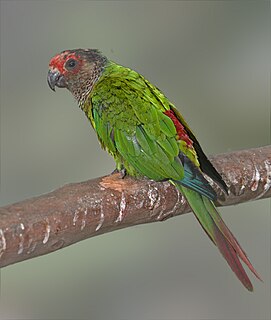
The blue lorikeet is a small lorikeet from French Polynesia and the Cook Islands. It is also known as the Tahiti lorikeet, violet lorikeet, Tahitian lory, blue lory, nunbird, and the indigo lory. It was formerly found on 23 islands around Tahiti, but now restricted to perhaps eight islands: Motu, Manuae, Tikehau, Rangiroa, Aratua, Kaukura, Apataki, Aitutaki, and possibly Harvey Island and Manihi. Its plumage is mainly dark blue and it has a white area over its upper chest, throat and face. The first captive breeding in the UK was by the Marquess of Tavistock in the 1930s. He was awarded a silver medal by the Foreign Bird League for this achievement.
Kielmeyera peruviana is a species of flowering plant in the Calophyllaceae family. It is found only in Peru.

Noblella peruviana is a species of frog in the family Craugastoridae. It is endemic to the Andean highlands in Peru.

Bolitoglossa peruviana is a species of salamander in the family Plethodontidae. It is found in Ecuador and Peru. Its natural habitats are subtropical or tropical moist lowland forests, plantations, and heavily degraded former forest.

The coastal miner is a species of bird in the family Furnariidae. It is endemic to Peru.

The Peruvian antpitta is a species of bird in the family Grallariidae. It is found in Ecuador and northern Peru.

The parrot-billed seedeater is a small species of bird in the family Thraupidae. It is found in various shrubby habitats in western Ecuador and western Peru. Outside the breeding season, it is quite social and frequently seen in flocks with other small seed-eating birds.

The black-backed tanager is a species of bird in the family Thraupidae. It is endemic to forest and shrub into south-eastern Brazil. When first described it was mistakenly believed that it originates from Peru, leading to the misleading scientific name peruviana. It is closely related to the chestnut-backed tanager, and the two have sometimes been considered conspecific.
Centronia peruviana is a species of plant in the family Melastomataceae. It is endemic to Peru.

Haplorhus is a genus of plants in the family Anacardiaceae. Haplorhus peruviana is the only species in the genus. It is found in dry ravines located in Chile and Peru.
Pentagonia peruviana is a species of plant in the family Rubiaceae. It is endemic to Ecuador.
Rondeletia peruviana is a species of plant in the family Rubiaceae. It is endemic to Peru.
Symplocos peruviana is a species of plant in the family Symplocaceae. It is endemic to Peru.
Vantanea peruviana is a species of plant in the Humiriaceae family. It is endemic to Peru.

The rose-fronted parakeet, also known as the red-crowned parakeet, or, in aviculture, the rose-fronted conure, is a species of parrot in the family Psittacidae. It is found in the western Amazon basin in eastern Peru, far south-eastern Ecuador, north-western Bolivia and far western Brazil. It includes the wavy-breasted parakeet, also known as the wavy-breasted conure, which sometimes is considered a separate species.

Cascabela thevetia is a poisonous plant native throughout Mexico and in Central America, and cultivated widely as an ornamental. It is a relative of Nerium oleander, giving it a common name yellow oleander, and is also called lucky nut in the West Indies.

The Peruvian warbling antbird is a species of bird in the family Thamnophilidae. It was considered a subspecies of Hypocnemis cantator, but based on vocal differences and to a lesser degree differences in plumages, it has been recommended that they be treated as separate species. As presently defined, the Peruvian warbling antbird includes a single subspecies, saturata. It has a black, white, and grey head and breast, with rufous flanks and a dull brown lower back and tail.
The Peru blind snake is a species of snake in the family Leptotyphlopidae.

Selene peruviana, the Peruvian moonfish or Pacific moonfish, is a species of jack in the family Carangidae. It is found in the eastern Pacific Ocean.

The Marañón dry forests (NT0223) is an ecoregion in northern Peru. It covers the lower valley of the Marañón River and its tributaries along the eastern edge of the Andes. It has a dry climate due to rain shadow from mountains further east. The habitat has long been modified by farming, ranching and logging and is now threatened by construction of hydroelectric and irrigation dams.













